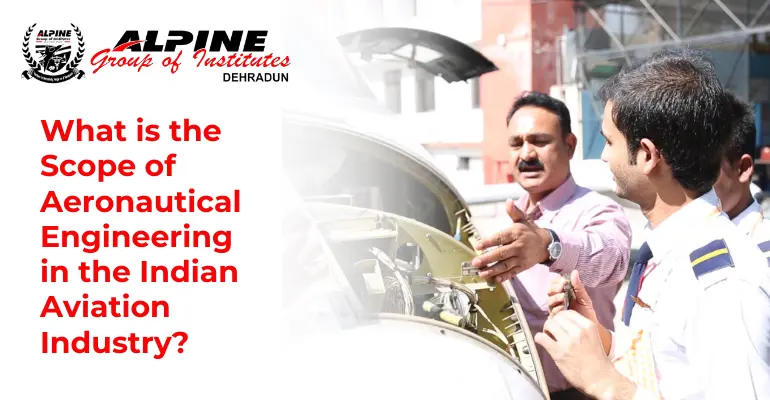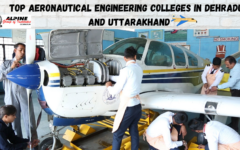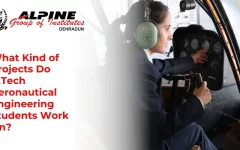What is the Scope of Aeronautical Engineering in the Indian Aviation Industry?
2024-12-16 10:19What is the Scope of Aeronautical Engineering in the Indian Aviation Industry?

What is the Scope of Aeronautical Engineering in the Indian Aviation Industry?
India’s aviation sector has been experiencing significant growth over the last few years, and the demand for skilled aeronautical engineers is soaring. The country’s burgeoning air travel market, advancements in aerospace technology, and strong government support for aviation infrastructure make it an exciting time for aspiring aeronautical engineers.
Growth of the Aviation Sector in India
India is one of the fastest-growing aviation markets in the world. According to the International Air Transport Association (IATA), India is expected to become the third-largest aviation market by 2024, surpassing the United Kingdom. Several factors are driving this growth:
- Rising Air Travel Demand: With a population of over 1.4 billion people, air travel in India has become more accessible. The middle class is expanding, disposable incomes are rising, and airfares are becoming more affordable due to increased competition.
- Government Initiatives: The Indian government has implemented several initiatives, such as the UDAN (Ude Desh ka Aam Naagrik) scheme, which aims to make air travel affordable and accessible to smaller cities and towns. This has led to an increase in regional air travel and the expansion of aviation networks across the country.
- Growth of Domestic Airlines: Carriers like IndiGo, Air India, SpiceJet, and GoAir have expanded rapidly, offering more routes and increasing fleet size. Low-cost carriers (LCCs) are particularly driving the growth in the sector.
- Infrastructure Development: India’s airport infrastructure is rapidly expanding, with new airports being built and older ones undergoing modernization. The expansion of airports, particularly in tier-2 and tier-3 cities, is creating more opportunities for the aviation industry.
Demand for Aeronautical Engineers in India
With the rapid growth of the aviation sector, the demand for aeronautical engineers is expected to rise in tandem. India has a limited supply of qualified aerospace professionals, creating a significant opportunity for B.Tech graduates in aeronautical engineering. Here’s why:
- Aircraft Design and Manufacturing: As domestic airlines increase their fleets, there’s a growing need for skilled engineers who can design, manufacture, and maintain aircraft. Companies like Hindustan Aeronautics Limited (HAL) and Bharat Electronics Limited (BEL) are key players in this space, offering ample opportunities for aeronautical engineers.
- MRO (Maintenance, Repair, and Overhaul): With more aircraft in operation, there is an increasing demand for MRO services. India is expected to become a global hub for MRO services, which will require a large number of engineers specializing in aviation maintenance and repairs.
- Aviation Safety and Certification: India’s Civil Aviation Ministry and the Directorate General of Civil Aviation (DGCA) are constantly working on ensuring aircraft safety, which involves continuous testing, certification, and maintenance of aircraft. This necessitates highly trained aeronautical engineers to ensure compliance with international standards.
- Aerospace Research and Development: The Indian government has invested in several aerospace R&D programs through organizations like ISRO and DRDO. Aeronautical engineers can contribute to cutting-edge research in aircraft, drones, and satellite technology, providing immense growth potential in the field.
- Increasing Role of UAVs and Drones: The use of drones and unmanned aerial vehicles (UAVs) is gaining traction across industries like defense, agriculture, logistics, and surveillance. The Indian government is also focusing on creating a regulatory framework for drone operations, which will open up more opportunities for aeronautical engineers to work on drone design, development, and regulation.
Challenges in India’s Aerospace Industry
While the opportunities are vast, the aerospace industry in India faces several challenges:
- Skilled Talent Shortage: Despite the growing demand for aeronautical engineers, there is a shortage of skilled professionals. Many Indian universities do not offer specialized programs in aeronautical engineering, and there is a gap in practical training, making it difficult for graduates to meet industry demands.
- Infrastructure and Funding Constraints: While India is expanding its aviation infrastructure, there are still significant gaps in terms of high-end technology, research facilities, and investment in innovation. Limited funding for R&D hampers the development of indigenous aircraft and aerospace technologies.
- Regulatory Hurdles: The Indian aviation industry is governed by strict regulations from the DGCA and other authorities, which can slow down the pace of innovation and development. Compliance with international standards for safety and design also remains a challenge for domestic manufacturers.
- Competition from Global Players: India’s aviation market is highly competitive, with international players like Boeing and Airbus dominating the aircraft manufacturing sector. While India has made significant strides in indigenous aircraft development, competing with global giants remains a challenge in terms of technology, costs, and market penetration.
Opportunities in India’s Aerospace Industry
Despite these challenges, there are several promising opportunities for aeronautical engineers in India:
- Government’s Push for ‘Atmanirbhar Bharat’ (Self-Reliant India): The Indian government’s push for self-reliance in the defense and aerospace sectors provides a huge opportunity for Indian aerospace companies to design and manufacture indigenous aircraft. HAL, for instance, is working on the Tejas fighter jet, and the government is keen on boosting domestic production of civilian aircraft as well.
- Private Sector Growth: Private companies are increasingly entering the aviation sector. Companies like Tata Advanced Systems and Mahindra Aerospace are working on producing aircraft and components for both defense and commercial purposes. There is a growing demand for skilled engineers to work on manufacturing, design, and testing.
- Space Exploration and Satellite Launches: India’s space program, led by ISRO, is one of the most successful and cost-effective in the world. With India planning to send more missions to the moon and Mars, and the increasing demand for satellite launches, there are significant opportunities for aeronautical engineers to contribute to space exploration and satellite technology.
- Research in Sustainable Aviation: With the increasing emphasis on sustainability, aeronautical engineers in India have an opportunity to contribute to the development of eco-friendly aviation technologies. This includes the design and production of electric aircraft, the use of sustainable fuels, and innovations in fuel efficiency.
- Growing Drone Industry: The Indian drone market is expected to grow exponentially, and aeronautical engineers will play a key role in designing and manufacturing drones for commercial, defense, and civilian applications. There is an increasing demand for engineers to work on UAVs, drone technology, and related fields.
Government Initiatives and Collaborations with Global Aerospace Companies
The Indian government is playing a pivotal role in shaping the future of the aerospace sector by promoting various initiatives:
- Aerospace and Defense Policy: The government has formulated policies to support domestic aircraft manufacturing, encourage foreign investment, and promote exports. The Defence Procurement Procedure (DPP) focuses on indigenization and the creation of more opportunities for domestic manufacturers.
- Public-Private Partnerships: There are growing collaborations between public sector organizations like HAL and private sector players to work on aerospace technologies. This includes joint ventures with global aerospace giants like Airbus, Boeing, and Lockheed Martin to enhance local manufacturing capabilities and expertise.
- Skill Development Programs: The government has also recognized the need for skill development in the aviation sector. Initiatives like the Skill India campaign and partnerships with international aviation organizations aim to improve the quality of education and training for aeronautical engineers.
- FDI in Aerospace: India has opened up the aerospace sector to Foreign Direct Investment (FDI) up to 100% under the automatic route for defense and aerospace manufacturing. This is expected to increase technology transfer, create jobs, and improve the competitiveness of the Indian aerospace industry.
Conclusion
The scope of aeronautical engineering in India is vast and expanding. With the growth of the aviation sector, increasing government support, and emerging opportunities in aerospace and defense, the demand for skilled aeronautical engineers is set to rise. While challenges such as talent shortages and competition from global players exist, the opportunities to contribute to India’s aerospace success are abundant. For aspiring aeronautical engineers, India offers a dynamic, fast-growing, and exciting environment to build a rewarding career.








